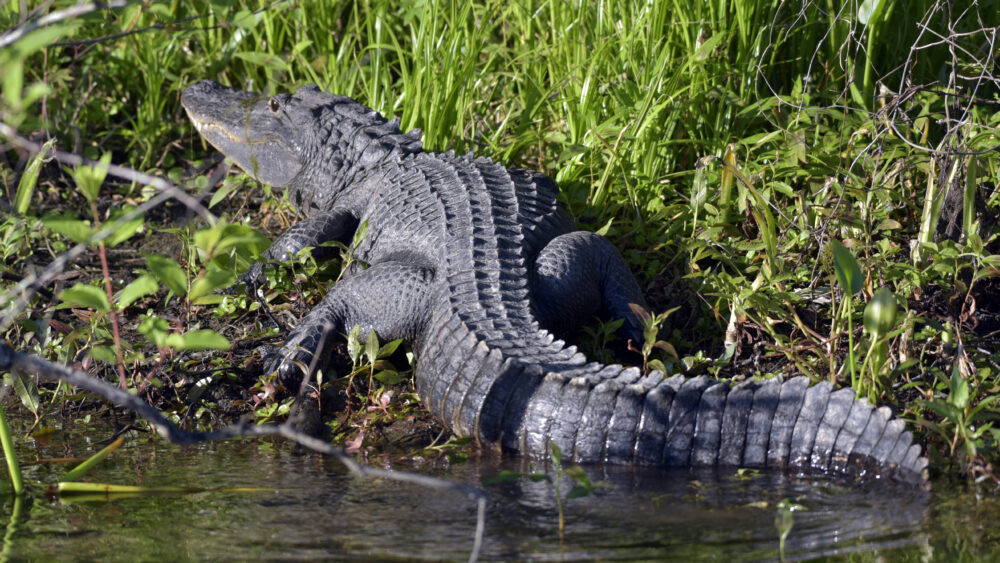We have much more to do and your continued support is needed now more than ever.
National Frog Month: 6 Ways to Tell If You Are a Frog
A concerned reader writes: “I hear that April is National Frog Month, so I would like to know, how do I tell whether I am a frog? And if I am one, can I get some sort of government benefits during National Frog Month?” (signed) Ambivalent Amphibian, living in the Land of Whimsy (The Land of Whimsy lies precisely on the US/Canadian border; nearly 3,000 miles long, it is nothing wide, making it hard to visit unless you book a flight of the imagination). To these questions I respond:
Dear Ambivalent Amphibian:

If you are a frog you get government benefits year round through programs that protect wetlands and other places frogs can’t live without. If you are especially rare, you might get benefits from the Endangered Species Act. You can also get benefits from private efforts, such as protected areas provided by people who sign up for NWF’s Backyard Habitat program and offer living space for frogs.
To get these benefits you must first, as you wisely suggest, establish if you are a frog. Frogs do differ widely from other animals. Here are six ways to tell if you are a frog:
- Do friends often call you a toad? If you answer yes, then you may be a frog. Frogs and toads belong to a group scientists call Anurans (meaning, “without tails”), and there is no real difference, scientifically speaking, between frogs and toads. Basically, toads are frogs that may spend most of their time on dry land. As a result, they tend to have drier skin than more water-oriented frog species and their skin is likely to be rougher, which helps camouflage them in the knobby world of dirt, sand and leaf litter. So if you look like a toad, there is a good chance you are a frog.
- Do you have four legs? Frogs are four-legged creatures. They also may have webbed feet, a trait especially common in water-loving frogs, or they may have little round pads at the tips of their toes with skin especially designed for climbing, a useful trait for frogs that live in trees. Regardless of your feet, if you look like a toad and have four legs, you may be a frog.
- Are your hind legs built for leaping? Frogs typically have long hind legs with extra joints, unknown in mammals, that help frogs leap usually far. Muscles in the hind legs are long and powerful, especially those used for jumping—the muscles used to get legs back into place after a leap are much smaller and weaker. How good are frogs at jumping? Well, the best is probably the Australian rocket frog, which can jump 50 times its body length—covering more than 6 feet of ground. This leap would be like a 6-foot tall man jumping the length of a football field. If you look like a toad, have four legs, and your hind legs are built for jumping, you may be a frog.
- When you were young, did you have a tail and gills and live in water? If so, you may have been a tadpole, sometimes called pollywogs. Tadpoles have gills and have long tails that help them swim with speed and agility. Most eat nothing but algae and other small plants, but some may eat insects and their young. They hatch from soft, shell-less eggs that their mothers lay in ponds or in the quiet pools of streams. Mothers may lay their eggs at the end of winter, when the water is still cold and therefore holds more oxygen than it will later in the year when temperatures rise. Not all frogs lay eggs in water, though. Some frogs carry their eggs on their backs, or in their mouths, or even keep their babies in their stomachs until they are ready to enter the world. But most frogs start out as eggs in water and hatch into tadpoles. Then, in one 24-hour period, the tadpole changes into a frog—its eyes move to the top of its head, its gills disappear, its legs show up and its body shortens. If you look like a toad and have four legs, the hind ones designed for leaping, and you were once a tadpole, you are very likely to be a frog.
- Do you eat mostly or entirely meat? Most adult frogs eat only insects, worms, and, sometimes—if the frog is large—small mammals and even baby water birds, such as ducklings. The biggest frog of all is West Africa’s Goliath frog, which can weigh more than 6 and1/2 pounds—the size of a small house cat. The largest U.S. frog is the bullfrog, which can reach a full pound. The important point here is, do you eat only or mostly other animals? If you look like a toad and have four legs, the hind ones designed for leaping, and you were once a tadpole, and you eat mostly or only other animals, you are almost certainly a frog.
- Can you breathe through your skin? All but one of the 5,000 known frog species have lungs for breathing on land, but they also can breathe through their skin when in water. However, frogs don’t have the ribs and muscles that help birds and mammals to breathe. Frogs breathe by puffing out the throat and squeezing the floor of the mouth, so when you watch a frog breathe, you will see its throat moving. Do your chin and throat move when you breathe, and can you breathe through your skin? Then, if you also look like a toad and have four legs, the hind ones designed for leaping, and you were once a tadpole, and you eat mostly or only other animals, I would say, yes, you are a frog.
Finally, let’s look at some things that don’t rule out the possibility that you are a frog. If you live in trees, you may still be a frog, because many frogs, especially in the tropics, live and even breed in trees. If you are poisonous, like certain plants, you still may be a frog—many frog species secrete skin chemicals poisonous to mammals, birds and other creatures that may feed on them, including humans. Some South American Indian people use the skin secretions of certain frogs to poison the tips of hunting darts. You do not even have to be green to be a frog (though if you live in a pond full of green plants, being green may help you hide from prey and enemies). Some frogs are bright red or blue or yellow—often these bright frogs are poisonous, and their color warns predators away from them.
So that’s it. If you do turn out to be a frog, have a happy National Frog Month and learn more about frogs at:
Living with Frogs
“Want to Host a Garden Party for Frogs?”
Fun with Frogs





















